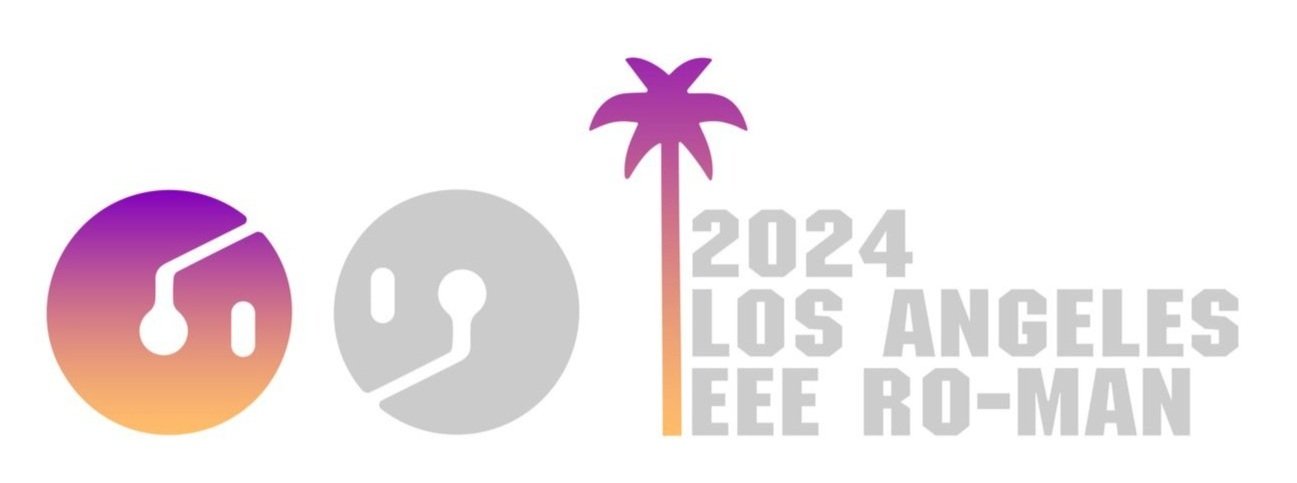
ROBOT DESIGN COMPETITION
The Robot Design Competition
For the 33rd IEEE International Conference on Robot and Human Interactive Communication, RO-MAN 2024, we are inviting submissions to the Robot Design Competition. The competition has three primary goals:
1. To provide teams a platform to demonstrate their vision and creativity in human-centered Human-Robot Interaction.
2. To bring together researchers and students from different backgrounds to work together, including engineering, computer science, art/design, and social sciences.
3. To give the teams a chance to have hands-on experiences and implement their ideas in HRI-related projects.
The Design Challenge and Context
Building upon this year’s conference theme of “Embracing Human-Centered HRI”, participating teams will develop interactive robotic objects that demonstrate that interactive robotic objects can enhance human well-being through interaction. Such objects, potentially in the form of a system, interface, or robot, should showcase their feasibility to focus on human physical or mental aspects, such as health, convenience, happiness, rehabilitation, work efficiency, and safety. We encourage participants to identify and focus on a particular interaction context, develop their interactive robotic objects, and create scenarios that illustrate how their robotic objects fit within the lives of the humans involved.
Robotic Objects: Robotic objects are any automatically operated mechanisms to replace or enhance human efforts. There is no limitation at all on robotic object design. Please be creative! For design components, it’s fine to build upon: off-of-the-shelf robots, open-source codes, market products, homemade hardware, customized software, and existing tools with valid licenses for personal-use purposes. And, of course, small hacks from your lab or a twist of your existing project are highly welcomed! The competition focuses more on the design of compelling interactions that delight, impress, and inspire! Don’t be bothered too much to demonstrate technical proficiency.
Design: We recommend that participants consider the following design questions:
1. How does this robotic object focus on humans? How does this robotic object actively communicate with humans and understand real human needs?
2. What is the scenario of the human-robot interaction? What is special about this setting?
3. What urgent need(s) does this interaction solve in the real world?
4. In that real-world setting, who are the most important users/stakeholders?
5. What are the target activities for the robotic object to enhance? And what are the current limitations of these activities without robotic assistance?
Process: To distinguish this year’s Robot Design Competition, we encourage participants to focus their robotic objects on the human aspect. It is preferred to analyze the human needs in interaction, demonstrate the human state sensing/communication functionalities, include the human in the interaction loop, and showcase the interaction in real-life settings.
We encourage you to tell a creative story for each project, with humans in the center.
Competition: Teams will show their interactive robotic objects: 1) as a demonstration during the Robot Design Competition session at the conference, and 2) in a poster displayed for the duration of the conference. Winners will be announced at the end of the conference during the closing ceremony. A jury of RO-MAN community luminaries will select winners based on the merit of these aspects.
● Technical Design. Includes, for example: the robotic functionalities, sketches, prototypes, and/or showcase videos.
● Context Design: Includes, for example: user needs, user testing and feedback, interaction motivation, and user community investigation.
● Demonstration: The best demo at the conference venue that has real-time human-robot interaction. Even the noise the crowd makes at the conference counts!
The jury will consider these aspects and select the top three teams with the most outstanding combined contributions. The top three teams will be awarded Gold, Silver, and Bronze prizes.
Important Dates
● 27 June 2024 —> 3 July 2024: Submission deadline of 11:59pm, anywhere on earth.
● 5 July 2024 —> 11 July 2024: Acceptance notifications.
● 12 July 2024 —> 17 July 2024: Final versions due.
● 28–31 August 2024: The RO-MAN 2024 conference. The competition will happen at the conference venue. Winners will be announced during the conference’s award ceremony.
Competition Guidelines
Procedure: Teams should design, build, and document their projects during the timeframe before the RO-MAN 2024 conference. We encourage teams to photograph and video record their design and development process, to include as learnings during final presentations.
Participants: We invite students, researchers, educators, and industry practitioners from all stages of their university or professional careers, as well as any disciplinary focus area. While not required, we encourage multidisciplinary, even international, team membership.
Team Size: In case of team participation, we suggest no more than 5 members. If your team has reason to exceed this number, please check with the Chairs first.
Registration: Registration for the competition itself is free, although at least 1 member of each team must register for, and attend, the RO-MAN 2024 conference.
Submissions: There is no limit to the number of entries per university or organization. We encourage each participant to focus on a single team entry, although participants are permitted to join multiple teams.
Jury and Judging: A jury composed of experts in design, robotics and/or interaction will assess each entry during a judging session held at the conference. The jury’s evaluations will determine the winners in the two categories of the competition.
Submissions and Presentations
Initial Submissions: Robot Design Competition participants should prepare an initial submission and email it to competition@ro-man2024.org by the deadline date of 3 July 2024. Creating and emailing an initial submission is how teams enter the competition and indicate that they’re working on a project.
Each team’s initial submission should be a 2-4 page pictorial, following the call, that includes:
● Project title and authors (names, affiliations, and email addresses).
● An abstract of 150 words or fewer
● A brief description should include but not limited to design context, the human involved, the scenarios, and the activities. Descriptions of both the technical and behavioral aspects are encouraged so that the Chairs can better evaluate the project.
● One or more visualizations of the interactive robotic object. The image can be in the format of photographs, CAD models, hand-drawn sketches, digital images, or even AI-generated images (with proper attribution).
Presentations: We expect that the Robot Design Competition session will coincide with the conference poster session, but we will announce details later. During the session, teams will present (show and tell) their interactive everyday objects to the competition jury and conference attendees as they pass by.
At the conference, each participant or team should present:
1. Either (a) the interactive everyday object itself to demonstrate in person, or (b) a video that shows the project in context and in action, interacting with people. We strongly encourage teams to bring and show their interactive everyday objects in person, as the most informative and entertaining representation of their work. We understand that some projects may be too large or delicate to travel well, and ask teams in this situation to focus their videos on demonstrating interactions.
2. A poster (we’ll determine specifications shortly) that includes the project title, authors and affiliations, description of the design concept, images showing the interactive everyday object within an interaction context, and other background that the team feels is relevant to communicate their efforts. We encourage teams to build upon the content included in their initial proposals and final designs.
3. Five or more images (renderings or photographs) that show the project in various stages of design development. The first should include the original, unmodified state of the purchased or found object, and the last should show its final, interactive form. The idea is to communicate the team’s design process, including (highlighting!) failures, learnings, and successes along the way. While most conference venues emphasize completed works, we celebrate the design process itself.
Jury and Awards
The RO-MAN community is very diverse, including researchers and practitioners from computer science, engineering, social science, art, and design. The goal of the competition is to recognize outstanding contributions from a combination of these disciplines. Therefore, there will be 3 awards of Gold, Silver, and Bronze awards, with prizes of $1000, $800, and $500, respectively.
Contact Us
The RO-MAN 2024 Robot Design Competition Chairs are:
· Nik Martelaro, Carnegie Mellon University, Pittsburgh, USA
· Jangwon Lee, Sungkyunkwan University, Seoul, Korea
· Wenhua Fan, UBTECH Robotics, Shenzhen, China
· Zhaobo Zheng, Honda Research Institute, San Jose, USA
Email: competition@ro-man2024.org
